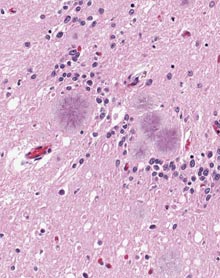Researchers have made a list of blood proteins that act as early indicators of a group of diseases including bovine spongiform encephalopathy (BSE), also known as mad-cow disease. Their results could lead to commercial early warning tests for the disease in farm animals. The methods used for the study–one of the most comprehensive analyses of the gene expression characteristic of a disease–are now being applied to other diseases and could lead to early diagnosis tests for other neurological diseases such as Alzheimer’s.

The human form of BSE, a fatal degenerative neurological disorder called Creutzfeldt-Jakob disease, can be contracted by eating meat contaminated with infectious agents called prions. Prions are proteins that cause other proteins to misfold, particularly in the brain and other neural tissue. In the first stages of the disease, prions replicate and accumulate in the brain. This is followed by abnormal activation of supportive cells, the degeneration of neural connections, and finally brain-cell death. By the time the disease can be diagnosed, these processes are already well under way.
In order to illuminate these ordinarily invisible processes, the researchers infected mice with prions and followed changes in the expression of every single gene in their brains at 10 points throughout the course of the disease. This global approach generated about 30 million data points. In order to separate signal from noise–that is, to find genes that were truly a significant part of the disease process–the researchers developed new statistical methods for looking at how the genes interact with one another in interrelated groups. Of an initialgroup of 7,400 implicated genes, they winnowed the number down to about 300 that are “at the heart of prion response,” says Leroy Hood, president and co-founder of the Institute for Systems Biology in Seattle, WA. Hood has pioneered this type of analysis, which he calls systems biology, over the past decade and led the new research with George Carlson, director of the McLaughlin Research Institute in Great Falls, MT.
Don’t settle for half the story.
Get paywall-free access to technology news for the here and now.